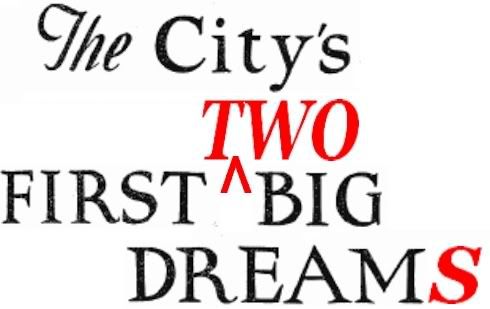
I had occasion yesterday, June 3, 2009, to be in the vicinity of NW 10th & May Avenue, and that fact jogged a memory of a conversation I had with Generals64, one of the Capitol Hill Old Guys (CHOGs) who posts frequently at OkcTalk.com, largely in its Nostalgia & Memories area. The conversation occurred at a monthly meeting of the CHOGs on May 16 last, and I fuzzily remembered what he said when driving around the fairgrounds on June 3. Paraphrasing liberally, the conversation went something like this:
Generals64: Are you familiar with the seldom used road that runs from east of the fairgrounds into downtown Oklahoma City?To myself, I wondered, "Is this another Urban Legend or what?" I made a mental note to check it out in the future.
Doug Dawg: Yes, I am.
Generals64: Do you know what that road originally was?
Doug Dawg: Well, no, I don't. What was it?
Generals64: It was originally a canal built in the early days of Oklahoma City which was to be navigable but when it was filled with water the water all seeped into the sand, and the project was abandoned.
Doug Dawg: Whoa! I need to check into that!
The future came more quickly than I expected. Recalling the conversation yesterday when in the vicinity, I took a drive down the road which we know today as General Pershing Boulevard which takes a meandering course from around NW 6th and May Avenue to Main Street and into downtown OKC at Main Street. The County Assessor's aerial maps, below, show the route — Pershing Boulevard is highlighted — click the images for larger views:
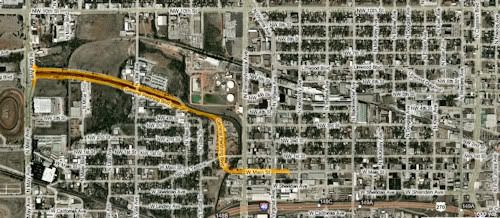
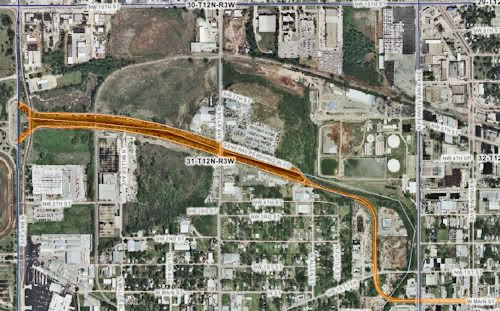
After driving the route, I got busy researching. This article presents the results.
Urban Legends? Maybe so — but not just one. There are two.
URBAN LEGEND #1: THE CANAL. In fact, the canal mentioned by the Capitol Hill Old Guy did occur. In a March 4, 1934, Daily Oklahoman article, it was described as ...
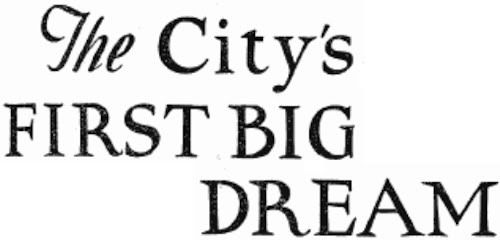
Before getting to that article, allow me to show you what I found in a marvelous little book, The Story of Oklahoma City by Angelo C. Scott (Times-Journal Publishing 1939), a book that before today I've paid little attention to. No more.
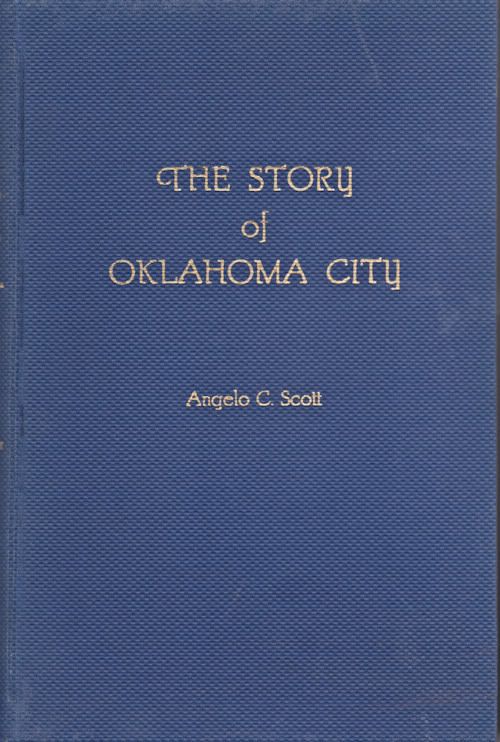
In his Preface, Scott wrote,
I have a more compelling reason for putting this record in permanent form than the hope of remuneration or the pleasure of seeing my writings in print, and this is my very deep conviction than an authentic story of Oklahoma City should be available not only to the readers of today but also to those of the future.My sentiments exactly! And so to you, Angelo C. Scott, I say to you from the from the future, "Thank you so much for what you have done. Those in your future are reading and learning from what you had to say."
Scott's credentials are almost vulgarly impressive.

And, so, when reading what he said about the early-day canal, I take it as accurately and authoritatively spoken when he wrote:
SINCE we are now in South Oklahoma, where the canal, that grand illusion of those early days, was dug in the winter of 1889-90, 1 shall speak of it here.A March 21, 1909, Daily Oklahoman ad by the Oklahoma Gas and Electric Company dittos much of the above in the following (click the article for a larger view, or read on for the article's content):
It is quite impossible to picture now the frenzy of anticipation we had about that ditch. One of our papers remarked that it alone was sufficient to "build a city." It was to be six miles and 320 feet in length, total fall 32.6 feet. The length of the river thus covered was about 15 miles. Captain Couch threw the first dirt on December 9, 1889.
This canal was actually constructed. It was not inaccurately termed by "Bunky" of the Gazette, "the most gigantic undertaking in Oklahoma Territory." It employed hundreds of men during that first winter who but for this employment would have suffered for the very necessities of life.
No wonder we anticipated its completion with enthusiasm. This came about in the spring, and there stood Jones's big new flour mill waiting for its waters. The Journal told in glowing words how the flood tide came and how the mill's machinery "functioned with perfect smoothness" and how the waiting electric lights "flashed forth." The next day the paper was still optimistic, but on the third day all the papers sank into silence.
For the appalling fact was that the canal itself had sunk into silence. The sand, on bottom, sides, and top absorbed the water. This calamity seemed incredible, too cruel to be true. Was there not another canal at Arkansas City, Kansas, running through pure sand, and running brimming full? our people asked. What, then, was the matter with our sand?
Nevertheless, the sickening fact remained that our canal, the very treasure of our hearts, would not function. You see, I speak of it still with emotion. It is often referred to with a laugh, but it was no joke to us. Every patriotic man in town had subscribed to it. I well remembered paying the final installment on my subscription after the last hope had vanished. For they did not give up at once. For six months or more they kept on, trying to harden and solidify the insatiable maw of the sand, but all in vain.
The men who sought so earnestly to put this "gigantic undertaking" across and sank thousands of dollars in it—"sank" is the word—deserve all honor.
C. P. Walker, the secretary of the company, stands first; but associated with him were C. W. Price (president), John Wallace (general manager), Robert Kincaid, B. N. Woodson, James B. Weaver, Frank A Weimar and W. H. Ebey.
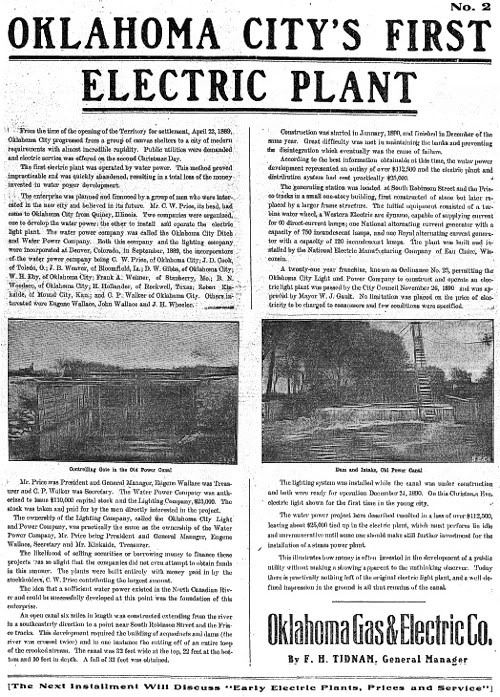
Part 1 of the article
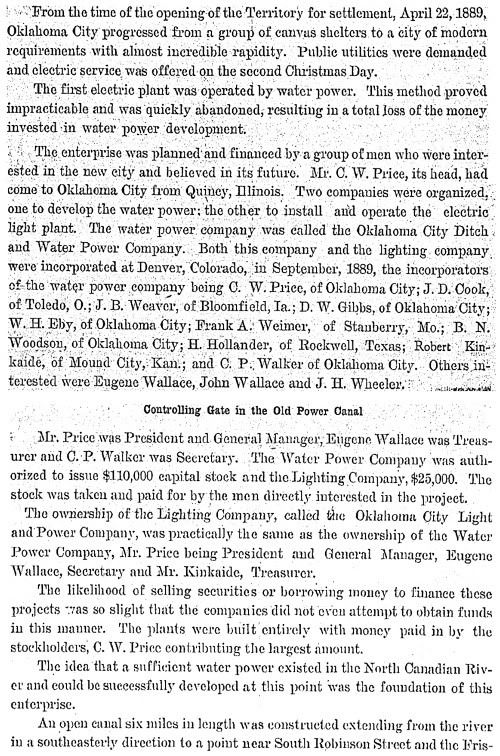
Part 2 of the article

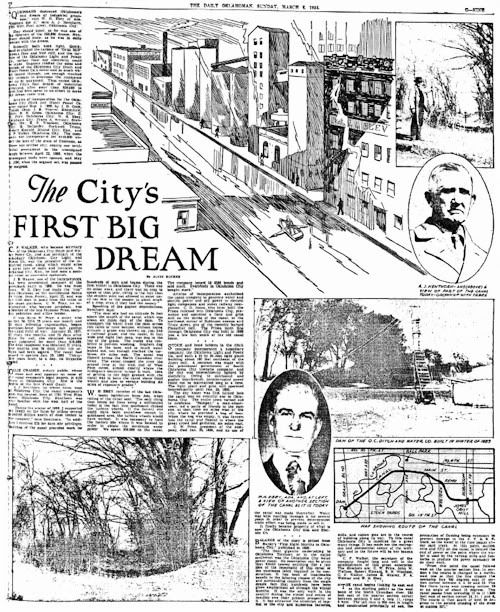
Close-up of the Concept Drawing
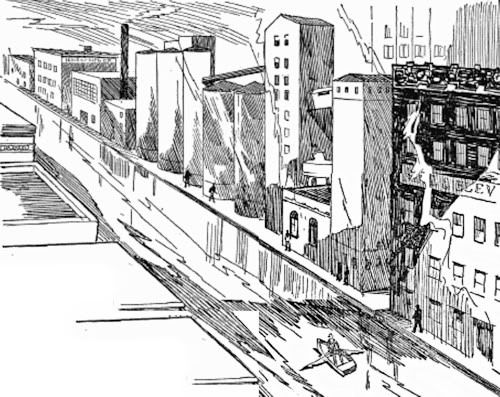
The article references a foreclosure action by Anna W. Price over non-payment of bonds which had a mortgage as security, decided in her favor by the Oklahoma Supreme Court. I've located that case and you can click here to read the decision on-line. Apparently a map was attached to the mortgage since part of the Supreme Court's opinion reads,
¶7 The exhibit "A", referred to in the above granting clause as being attached to and made part of the mortgage was a map consisting of lines showing the meanderings and course of the river and the course of the ditch and the various tracts of land which it crossed.So, probably a better map is available in the Oklahoma County Clerk, Registrar of Deeds office.
But, for now, I'll use the map contained in the above article which shows the canal's location:
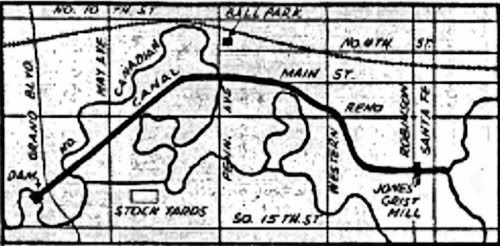
The Same Area Today
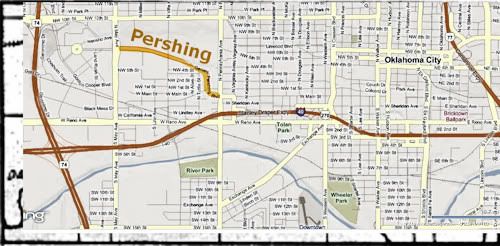
The Above Maps Superimposed
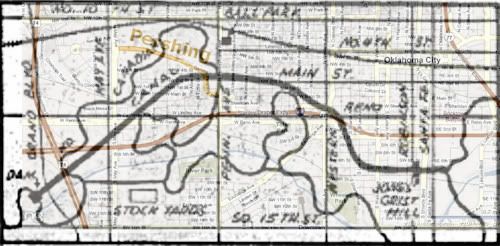
So, while the route of the canal and the path of General Pershing Boulevard do cross, they are not the same — but, hey, that's what urban legends are all about.
URBAN LEGEND #2: OKC's WORLD'S FAIR. What? We had a World's Fair here — did you sleep through it? No, we didn't, but we thought that we would and that's where General Pershing Boulevard came from.
The time was the very early 1980s and the city was feeling good about the Urban Renewal that was going on downtown. The Oil Boom was on, Penn Square Bank hadn't collapsed, downtown was being rebuilt, and most everyone was giddy.
The Centennial of the Land Run would occur in 1989. So, why not have a World's Fair to call attention to our bright new city?
A study was called for (per this February 20, 1981, article), the City Council agreed to do the study (per this March 4, 1981, article), the Chamber of Commerce got on board (per this November 7, 1981, article), the City Council decided to do the deal per this December 4, 1981, article, and everything seemed good to go.
It was decided that the event would occur at an improved State Fairgrounds and, of course, a nice new boulevard would be needed to get all those visitors to our shiny new downtown being generated by Urban Renewal. AND THAT'S WHY the meandering road from the fairgrounds to downtown came to be. This March 22, 1982, article shows that the name of this fine new just-completed road would be General Pershing Boulevard.
In early 1982, the Oil Bust began; Penn Square Bank was declared insolvent on July 5, 1982; and before it was done 139 other Oklahoma Banks came to fail or be absorbed by other financial institutions, including, of course, the city's mainstay and pride and joy, the First National Bank.
Although the horizon was darkening, the downturn hadn't fully set in by the summer of 1983. A July 7, 1983, article sounded like our chances were good for landing the fair. The beautiful proposed hotel shown below appeared on the same page as the July 7 article ...
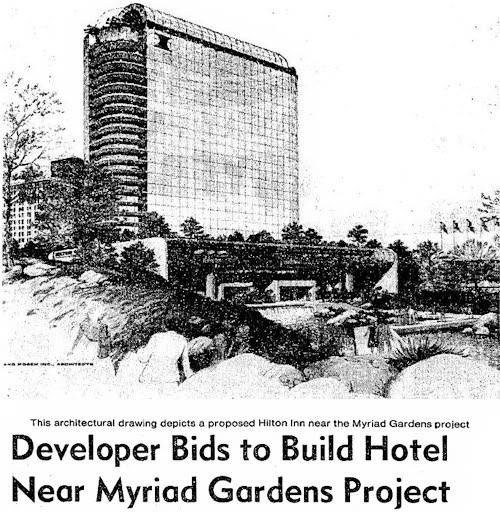

This August 10, 1983, article shows the great new things planned for the State Fair Grounds.
But, the times, they were a-changing. Coupled with the economic downturn, the huge losses sustained by Knoxville and New Orleans from their World's Fairs came to light. In summer 1984 the planned World's Fair was trimmed from its theretofore standard six months to three months, and then down to one, per this August 15, 1984, article. But, shortly thereafter, the fair was nixed altogether, per the September 13, 1984, article shown below:
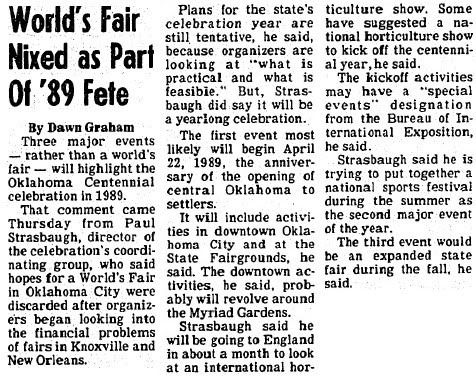
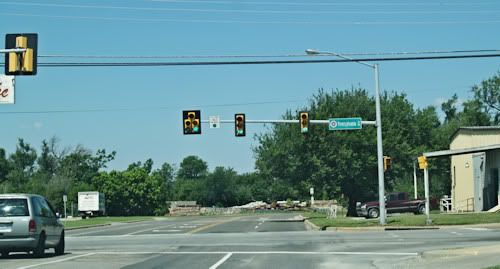
Following the meandering road toward the State Fair Grounds


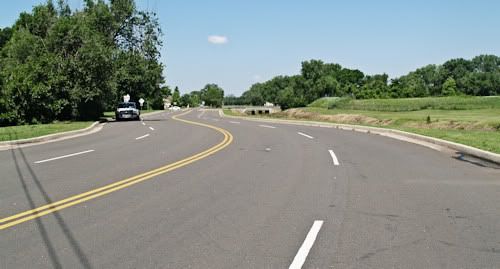
Ahh ... there's that Urban Legend Canal
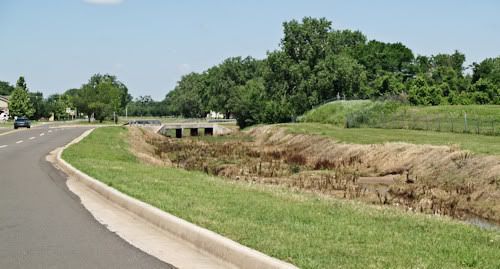
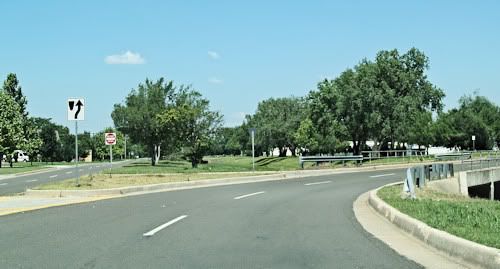
More of the Urban Legendary Canal
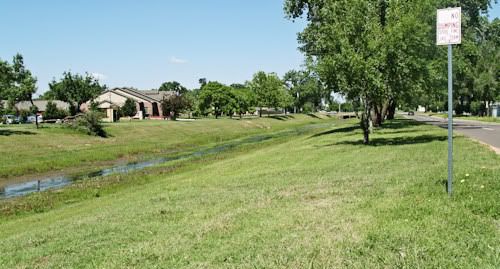

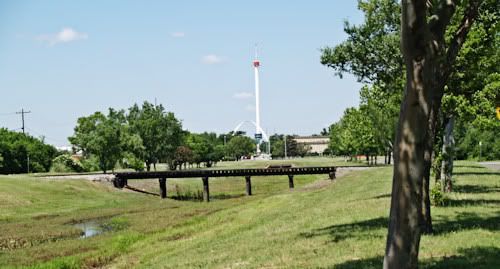
At May Avenue and the Turnaround To Downtown
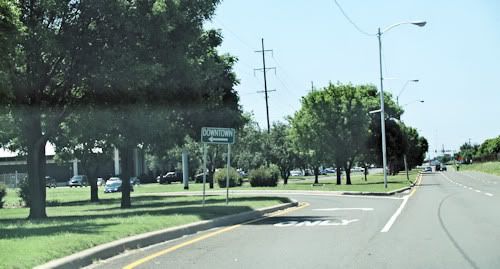
Heading East Toward Downtown
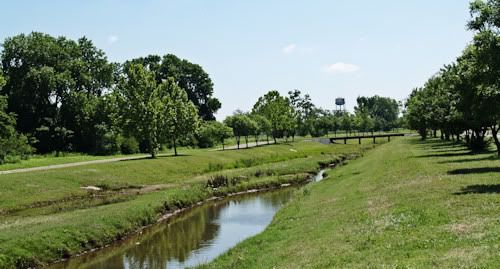

At Villa
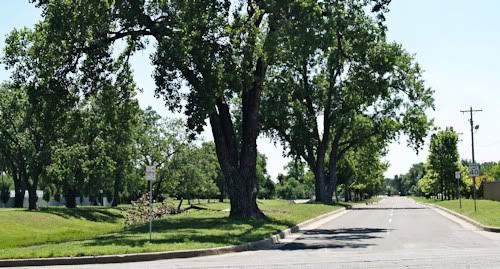
Here we are back at Pennsylvania & Main
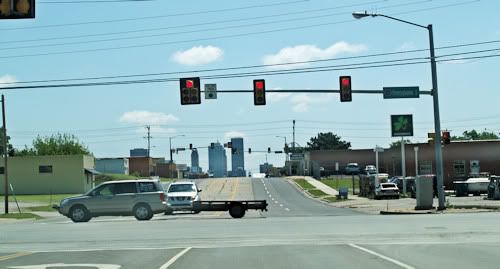
Sooo .. one story by a Capitol Hill Old Guy led to all of this, a small study in Oklahoma City Urban Legends.














8 comments:
Oh my, you don't know how long I've been curious about that piece of road. I do drive on it, and every time I thought somebody must have had a good reason to build this. About the canal, that is new to me.
Thanks again Doug!
Thanks, Jason. It would have been so much fun to find out that the canal ditch was in fact the path of Pershing Blvd ... but I guess that's what urban legends are about.
Doug, What a fantastic job! I ask in all seriousness - do you ever feel you have found your true calling? If you had it all to do over again (which, of course none of us do), would you have been in your fourth decade or so as a historian, curator, something along those lines? I'm serious. I am glad you discovered this talent and are putting it to such good use. You're a treasure.
I'm blushing, Mike, and thanks. Yes, could we begin again, I would love to do this sort of thing for a lifetime.
Nice.
Always something new, Doug.
I'm trying to find out more about Bunky. To date I've only found his name was Irving Geffs, born 1860, and apparently(??) worked for the Evening Gazette. From the book, "The EVENING GAZETTE is the oldest daily newspaper in Oklahoma Territory. It was started by the McCaster Printing Company..." In the same book, there is mention of a Mrs. Geffs and her attire at the reception for the Congressmen.
It's a funny (as in strange) little book. But that's just my opionion.
Keep finding jewels!
(Now I have to go read Angelo's book!)
I guess firstly, I should thank you for teaching me to fish. Your tutorial on using the Oklahoman archives via the Metropolitan Library is easy to understand and fun to use.
One article, states he was "a soldier helpling to keep order at the time of the Run."
Another says he was a newspaperman in O.T. at the time of the Run.
But perhaps my favorite is "All that is known about Bunky is that he one night overindulged in drink and woke to discover himself enlisted in the U.S Army." It goes on to say he was shipped to I.T. and stationed at the Oklahoma Station during/after the Run. He remained in OKC after his discharge and wrote for local newspapers.
It is a (little) leap to think he worked for the Evening Gazette, but the book was published by McMaster Printing.
Still an amusing book.
Thanks for taking me fishin'.
Thanks, Rick. I just noticed your last comments. A couple of weeks ago I found a neat little booklet at the Ablaache Book Shop on Exchange (north of Langston's) called Fifty Years Forward, a 1939 publication celebrating 1st National Bank's 1st 50 years, and the 1st 45 pages of it are excerpts from the Bunky work. The last page of those excerpts describes the Oklahoma City Ditch & Water Power Company and the canal ... at the time, it was apparently being built but had not yet had time to fail. The paragraph concludes, "To this canal Oklahoma City is indebted for a great many things. It has made her the metropolis and commercial center of the Territory and in the future will be her beacon light."
First, do you know about the plaque dedicated to the canal. It is on the south wall of the Oklahoma Operating Company. I often take relatives there. I took my mom who said she had never heard about this plaque. It gives great details about the ends which was Broadway to the North Canadian River. It was features in a news article back a few months. According to street view it appears to be located at 801 SW 3rd. Look at the building marked "Oklahoma Operating Company" and find the two story part. Look at the South door on the left. There is the plaque. I hope Bob Blackburn can save this plaque if they decided to tear it down for 180 or CtoS.
Post a Comment